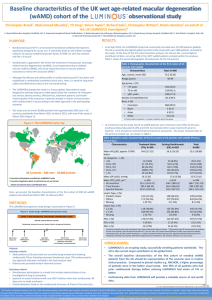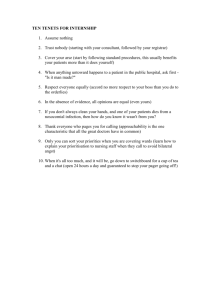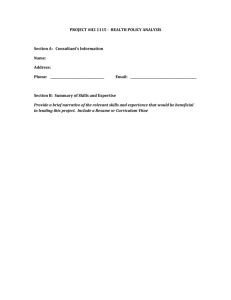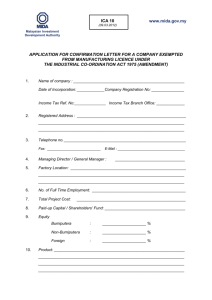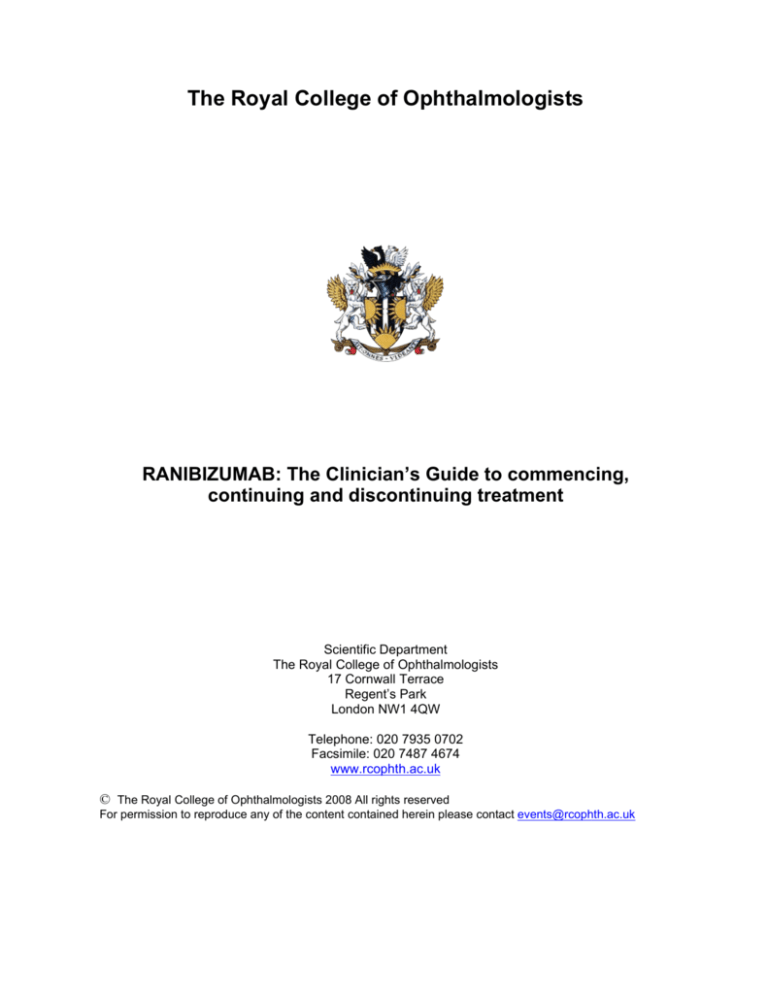
The Royal College of Ophthalmologists
RANIBIZUMAB: The Clinician’s Guide to commencing,
continuing and discontinuing treatment
Scientific Department
The Royal College of Ophthalmologists
17 Cornwall Terrace
Regent’s Park
London NW1 4QW
Telephone: 020 7935 0702
Facsimile: 020 7487 4674
www.rcophth.ac.uk
© The Royal College of Ophthalmologists 2008 All rights reserved
For permission to reproduce any of the content contained herein please contact events@rcophth.ac.uk
Ranibizumab: The Clinician’s Guide to commencing, continuing, and
discontinuing treatment.
The National Institute for Health and Clinical Excellence (NICE) Guidance has recommended
ranibizumab in the treatment of wet age related macular degeneration (AMD).1 The Institute further
recommended that a national protocol specifying criteria for discontinuation of ranibizumab is
developed. Criteria for discontinuation should include persistent deterioration in visual acuity and
identification of anatomical changes in the retina that indicate inadequate response to therapy.1
The Royal College of Ophthalmologists (RCOphth) recognised the need for such guidance and
brought together a group of clinicians with expertise in the treatment of AMD with ranibizumab,
NICE and Department of Health (DH) to develop this guide. The RCOphth has previously published
the minimum service specifications required for delivering a contemporary AMD service. This
document is accessible on the RCOphth website (www.rcophth.ac.uk) under publications.2
It is confirmed that LogMAR (ETDRS) vision charts, Optical Coherence Tomography (OCT) (OCT 3
or higher specification equivalent), and stereo fundus fluorescein angiography (FFA) are the
minimum requirements for adequate AMD service delivery. It is considered inappropriate for a
contemporary AMD service to be contemplated without these basic requirements.
When interpreting these guidelines it is important to recognise that clinical variations may occur at
each stage in the management of any individual case, and that the decision to commence, re-treat
or discontinue therapy rests with the clinician in consultation with the patient.
Ranibizumab: The clinician’s guide to commencing, continuing and discontinuing treatment
Scientific Department - June 2008
2
1.0
Criteria for commencement of treatment
1.1
Diagnosis of Active CNV lesion
A diagnosis of choroidal neovascularisation (CNV) should be confirmed by FFA, except in cases of
allergy that preclude this investigation, and OCT (Stratus OCT 3 equivalent or higher specification)
before commencement of therapy.
1.2
Visual Acuity
The Best Corrected Visual acuity (BCVA) should be 6/96 (LogMAR 1.2 or 24 ETDRS letters) or
better in the eye to be treated.
1.3
Structural damage to fovea
It should be established that there is no significant permanent structural damage to the fovea in the
eye under investigation before treatment is commenced. Significant structural damage is defined
as longstanding fibrosis or atrophy in the fovea, or a significant chronic disciform scar which, in the
opinion of the treating clinician, would prevent the patient from deriving any functional benefit (i.e.
prevent further loss of vision) from treatment.
1.4
Recent progression of lesion
CNV disease progression is defined as
a) the appearance of sight threatening CNV which was not previously suspected or thought to
be present or
b) evidence of new haemorrhage and/or subretinal fluid (SRF) or
c) a documented recent visual decline in the presence of CNV or
d) an increase in the CNV lesion size between visits
1.5
It is advised that the ranibizumab summary product characteristics (SmPC)3, and the NICE
Guidance on anti-VEGF therapies in AMD should be followed wherever possible.
Ranibizumab treatment is initiated with a loading phase of three injections at intervals of 4 weeks
followed by a maintenance phase in which patients are monitored with ETDRS (LogMAR) BCVA,
history and examination, and OCT and/or angiographic examination. The interval between two
doses should not be shorter than 4 weeks.
It is expected that all patients will receive the 3 loading doses of ranibizumab, unless there are
particular contraindications.
1.6 Other considerations when commencing treatment
a) Bilateral active CNV lesions
It is reasonable to treat both eyes in any one individual simultaneously, in the presence of bilateral
active subfoveal CNV, as long as asepsis is observed. For such simultaneous bilateral intravitreal
injections, a separate set of instruments must be used for each eye. Similarly, separate vials of
ranibizumab should be used for each eye. The patient should be made aware of the usual
cumulative risks of sequential injections either to each eye on separate visits or to both eyes on the
same visit.
b) Predominantly haemorrhagic lesions
Foveal haemorrhage or haemorrhage of greater than 50% of the total CNV lesion, are not
considered reasons to withhold treatment.
Ranibizumab: The clinician’s guide to commencing, continuing and discontinuing treatment
Scientific Department - June 2008
3
c) Raised intraocular pressure
Elevated intraocular pressure (IOP), even of >30mm Hg, should not preclude treatment provided
the IOP is treated simultaneously.
d) Intraocular surgery
It is advised that in the presence of wet AMD and cataracts, the wet AMD should be treated and
CNV activity controlled before proceeding to cataract surgery, wherever possible. If CNV is
diagnosed after intraocular surgery or there is reactivation, it is not necessary to allow 28 days
recovery before commencing ranibizumab. Attention, however, needs to be paid to the cataract
wound.
1.7
Criteria for not commencing treatment
It is recommended that treatment with ranibizumab should not be commenced in the presence of
a) Permanent structural damage in the fovea, as defined under section 1.3.
b) Evidence or suspicion of hypersensitivity to ranibizumab, or similar product. Such evidence
should lead to avoidance of therapy, and alternate treatments sought.
2.0
Criteria for Continuation of treatment
It is recommended that after the three loading doses, ranibizumab should be continued at 4 weekly
intervals if:
a) There is persistent evidence of lesion activity
b) The lesion continues to respond to repeated treatment
c) There are no contra-indications (see below) to continuing treatment.
Disease activity is denoted by retinal, subretinal, or sub-RPE fluid or haemorrhage, as determined
clinically and/or on OCT, lesion growth on FFA (morphological), and/or deterioration of vision
(functional).
3.0
Criteria for temporarily discontinuing treatment (dose withholding)
Consider temporarily discontinuing treatment if:
3.1 There is no disease activity
The disease should be considered to have become inactive when there is:
a) Persistent fluid in the absence of FFA leakage or other evidence of disease activity in the
form of increasing lesion size, or new haemorrhage or exudates (i.e. no increase in lesion size,
new haemorrhage or exudates)
b) No re-appearance or further worsening of OCT indicators of CNV disease activity on
subsequent follow up following recent discontinuation of treatment.
c) No additional lesion growth or other new signs of disease activity on subsequent follow up
following recent discontinuation of treatment.
d) No deterioration in vision that can be attributed to CNV activity.
Ranibizumab: The clinician’s guide to commencing, continuing and discontinuing treatment
Scientific Department - June 2008
4
3.2 There has been one or more adverse events related to drug or injection procedure including:
a) endophthalmitis
b) retinal detachment
c) severe uncontrolled uveitis
d) ongoing periocular infections
e) other serious ocular complications attributable to ranibizumab (drug) or injection procedure
f) thrombo-embolic phenomena, including MI or CVA in the preceding 3 months, or recurrent
thrombo-embolic phenomena which are thought to be related to treatment with ranibizumab
g) other serious adverse events (SAE) e.g. hospitalisation.
4.0.
Criteria for Permanent discontinuation of treatment
Consider discontinuing treatment permanently if there is:
4.1
a hypersensitivity reaction to ranibizumab is established or suspected
4.2
Reduction of BCVA in the treated eye to less than 15 letters (absolute) on 2 consecutive
visits in the treated eye, attributable to AMD in the absence of other pathology
4.3
Reduction in BCVA of 30 letters or more compared to either baseline and/or best
recorded level since baseline as this may indicate either poor treatment effect or adverse event
or both
4.4
There is evidence of deterioration of the lesion morphology despite optimum treatment.
Such evidence includes progressive increase in lesion size confirmed with FFA, worsening of OCT
indicators of CNV disease activity or other evidence of disease activity in the form of significant new
haemorrhage or exudates despite optimum therapy over 3 consecutive visits.
5.0
Criteria for discontinuing treatment and discharging patient from hospital eye
clinic follow up
Consider discharging the patient from long term hospital follow up if:
5.1 Decision to discontinue ranibizumab permanently has been made
5.2 There is no evidence of other ocular pathology requiring investigation or treatment
5.3 There is low risk of further worsening or reactivation of wet AMD that could benefit from
restarting treatment e.g. very poor central vision and a large, non-progressive, macular scar.
Ranibizumab: The clinician’s guide to commencing, continuing and discontinuing treatment
Scientific Department - June 2008
5
References
1. www.nice.org/guidance/index
2. www.rcophth.ac.uk/doc/publications/publishedguidelines/CommissioningContempAMDServices
3. Lucentis: Summary Product Characteristics. Marketing Authorisation EU/1/06/374/001
The membership of the group and commentators comprised:
Mr. Winfried Amoaku – Chairman. Associate Professor/Reader in Ophthalmology and Visual
Sciences, University of Nottingham and Consultant Ophthalmologist, University Hospital, Queens
Medical Centre, Nottingham
Miss Clare Bailey, Consultant Ophthalmologist, Bristol Royal Infirmary
Mr. Chris Blyth, Consultant Ophthalmologist, Cardiff
Professor Victor Chong, Consultant Ophthalmologist, Oxford Eye Hospital, Radcliff Infirmary,
Oxford, and Visiting Professor, Aston University
Professor Usha Chakravarthy, Consultant Ophthalmologist, Royal Victoria Hospital and Queen’s
University of Belfast
Mr Mick Cole, Consultant Ophthalmologist, Torbay Hospital and South Devon Healthcare NHS
Foundation Trust, Devon
Mr. Mike Gavin, Consultant Ophthalmologist, Gartnavel Hospital, Glasgow
Mr Faruque Ghanchi, Consultant Ophthalmologist, Bradford Royal Infirmary, Bradford
Professor Jon Gibson, Consultant Ophthalmologist, Birmingham and Midland Eye Centre, and
Aston University
Professor Simon Harding, Consultant Ophthalmologist, Royal Liverpool Hospital and University of
Liverpool
Professor Andrew Lotery, Consultant Ophthalmologist, Southampton General Hospital and
Southampton University
Ms. Geeta Menon, Consultant Ophthalmologist, Frimley Park Hospital, Surrey
Mr Ian Pearce, Consultant Ophthalmologist, Royal Liverpool Hospitals, Liverpool
Mr James Talks, Consultant Ophthalmologist, Newcastle Royal Infirmary
Mr Adnan Tufail, Consultant Ophthalmologist, Moorfields Eye Hospital, London
Mr Gavin Walters, Consultant Ophthalmologist, Harrogate General Hospital, Harrogate
Professor Yit Yang, Consultant Ophthalmologist, Wolverhampton Eye Hospital, and Visiting
Professor, Aston University
The contributions of the following are acknowledged:
Mr Aaron Osborne, MRCOphth, Senior Medical Advisor, Novartis
David Chandiwana, Health Technical Analyst, NICE
Derek Busby, Head Eye Care Team, DH
Matt Harpur, Senior Business Manager, Medicines Pharmacy and Industry Group, DH
Simon Reeve, Head of Clinical cost Effectiveness, Medicines Pharmacy and Industry Group, DH
Declarations
The Chair of this group has received Research funding from Novartis Pharma, Pfizer, Bausch and
Lomb, Bayer Schering, and Educational Travel Grants from Novartis and Pfizer. He has served on
Advisory Boards of Novartis and Pfizer, and is a member of the Scientific Advisory Board of The
Macular Disease Society. The commercial relationships of the other members of the group have
been declared in writing to the chair.
Date of Revision
July 2009 or earlier if there is evidence to necessitate such revision.
Ranibizumab: The clinician’s guide to commencing, continuing and discontinuing treatment
Scientific Department - June 2008
6


